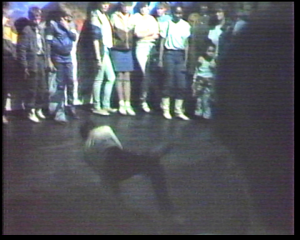
Screen shots from the Wild Bunch film
As a business situated in the heart of Bristol, Greatbear is often called upon by Bristol’s artists to re-format their magnetic tape collections.
Previously we have transferred documentaries about the St. Paul’s Carnival and films from the Bristol-based Women in Moving Pictures archive. We also regularly digitise tapes for Bristol Archive Records.
We were recently approached by author Phil Johnson to transfer a unique VHS recording.
As Bristol countercultural folklore goes, the video tape is a bit of a gem: it documents the Wild Bunch performing at Arnolfini in 1985.
For the uninitiated, the Wild Bunch were the genesis of what became internationally known as trip-hop, a.k.a. ‘the Bristol-sound.’
Members went on to form Massive Attack, while Tricky and producer Nellee Hooper continue to have successful careers in the music industry. And that’s just the short-hand version of events.
Want to know more? This documentary from 1996 is a good place to become acquainted.
We are delighted to feature a guest blog from Phil Johnson, author of Straight Outta Bristol: Massive Attack, Portishead, Tricky and the Roots of Trip-Hop, who filmed the event.
Below he beautifully evokes the social and technical stories behind why the video was made. Many thanks Phil for putting this together.
***
In 1985 I was a lecturer in Film and Communications at Filton College with an added responsibility for running the Audio Visual Studio, a recording room and edit suite/office that had dropped from the sky as part of a new library and resources building. There was also kit of variable quality and vintage, some new, some inherited. I remember a Sony edit suite for big, chunky u-matic videos and another JVC one for VHS tapes, with a beige plasticky mixer that went in the middle by the edit controller. This also allowed you to do grandiose wipes from one camera to another, although we rarely used the camera set-up in the studio because you really needed to know what you wanted to do in advance, and no one ever did. What students liked using were the portable cameras and recorders, JVC VHS jobs that together with the fancy carry cases and padded camera boxes, plus regulation heavy pivoting tripod, weighed each prospective al fresco film-maker down with the baggage-equivalent of several large suitcases. I remember one aspiring Stanley Kubrick from Foundation Art&Design setting off to get the bus into town carrying everything himself, and returning sweatily later that day, close to collapse. He was wearing a heavy greatcoat, obviously.
We had a ‘professional’ u-matic portable recorder too, and that was seriously heavy, but we didn’t have the requisite three-tube camera to get the quality it was capable of, never entirely understanding the principle of garbage in-garbage out, with the inevitable result that almost everything anyone did was doomed to remain at least as shoddy as the original dodgy signal it depended upon. But hey, this was education: it was the process we were interested in, not the product.